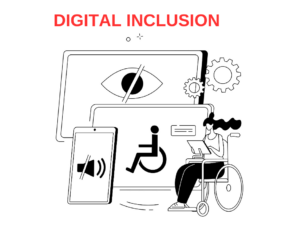Digital Inclusion: Bridging the information gap for people with disabilities
27 يوليو 2024
 Digital technology is becoming indispensable to everyday life and participation in society (EuroDIG Forum, 2023). Work, schooling, commerce, banking, and government services all increasingly have digital components or may even be conducted entirely online. Digital inclusion is a crucial aspect of modern society that cannot be ignored. With the rapid advancement of technology, there is a growing need to ensure that everyone has equal access to online or digital resources and information. For people with disabilities, this issue is particularly significant.
Digital technology is becoming indispensable to everyday life and participation in society (EuroDIG Forum, 2023). Work, schooling, commerce, banking, and government services all increasingly have digital components or may even be conducted entirely online. Digital inclusion is a crucial aspect of modern society that cannot be ignored. With the rapid advancement of technology, there is a growing need to ensure that everyone has equal access to online or digital resources and information. For people with disabilities, this issue is particularly significant.
As technology becomes more and more integrated into our lives, it is important to ensure that everyone has access to it. Digital exclusion is the lack of awareness, access to technology and digital skills to participate in the digital economy (Munyaradzi Z., et.al., 2022). This can be due to families of poverty, minorities, immigrant children, and special needs students. It can have a significant impact on people’s lives, limiting their opportunities for education, employment, and healthcare. It can also lead to social isolation and exclusion.
According to a study by the World Health Organization (WHO), approximately 15% of the world’s population, over one billion people live with some form of disability. This vast community needs equal access when it comes to accessing information and technology. For example, people with print disabilities need audio descriptions, while the deaf and hard of hearing people require captioning and sign language interpretation.
People with disabilities often face numerous challenges when accessing the internet and other digital platforms. In many cases, websites and online content are often not designed with accessibility in mind, making it difficult for people with disabilities to browse and comprehend information. This information gap can be detrimental and limits their ability to participate fully in the digital world.
There are a number of mechanisms to bridge the digital exclusion gap. These include designing inclusive digital transformation strategies, providing affordable access to technology, awareness creation, and developing digital content that is relevant to people’s lives and context. Teaching of various accessibility guidelines must be made mandatory in curriculum. Accessibility audit of web platforms should be done regularly so that it remains effective, and compliant while providing inclusive user experience. Overcoming the digital exclusion is essential to ensuring that everyone has the opportunity to participate in the digital age.
However, digital inclusion is not just a moral imperative; it should also be a legal requirement to guide the creation of accessible digital content, development of assistive technologies, and promotion of digital literacy among people with disabilities. This will ensure that everyone can fully participate in the digital world, regardless of their abilities.
The benefits of digital inclusion are clear. It promotes social inclusion, enhances educational opportunities, and improves employment prospects for people with disabilities. It also enhances their overall quality of life.
In conclusion, digital inclusion is one that we must address through designing inclusive digital transformations strategies, capacity building, and providing need based digital services and contents.
Authors: Maela Rakočević Uvodić, Priya Rangra, Tilahun Shiferaw – IFLA Libraries for People with Special Needs (IFLA LSN) Section
Photo: Image by vectorjuice on Freepik